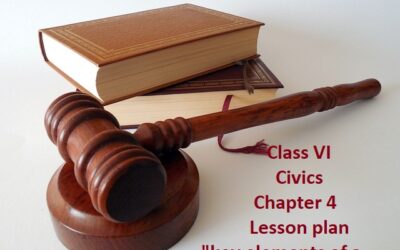Key Elements Of A Democratic Government Worksheet
Key Elements Of A Democratic Government Worksheet is designed for class VI students to test your understanding and knowledge. Welcome to the world of Key Elements Of A Democratic Government , a fundamental aspect of rural governance in India. This Key Elements Of A Democratic Government worksheet, is going to test you through a diverse range of question types.
In this worksheet, you will encounter fill-in-the-blanks questions to assess your grasp of key terms and concepts. Answer-in-one-word questions will challenge your ability to provide concise responses. Match the following questions will test your ability to pair related ideas. Assertion and reason questions will encourage critical thinking and analytical skills. Jumbled words will evaluate your vocabulary and spelling abilities. Lastly, you’ll have the opportunity to correct statements to deepen your comprehension of Key Elements Of A Democratic Government .
So, get ready to embark on this engaging journey into the world of rural governance in India, and let’s begin exploring Key Elements Of A Democratic Government !
Key Elements Of A Democratic Government Worksheet
Fill In The Blanks: assess your grasp of key terms and concepts
Here are some sample fill-in-the-blank questions related to the topic of “Key Elements of a Democratic Government” in Civics for Class VI, along with answers.
- In a democratic government, the ultimate power rests with the ________________.
- The process through which citizens choose their representatives is known as ________________.
- The head of the government in a parliamentary democracy is usually the _________________________.
- The Constitution of a country provides the _________________ framework for its government.
- In a democratic government, citizens enjoy the right to _________________ their leaders periodically.
- The three branches of government – legislative, executive, and judicial – ensure a system of ___________________.
- A government that is accountable to the people is said to be ___________________.
- The document that lays down the fundamental laws and principles of a country is its ___________________.
- In a federal system of government, power is divided between the central government and ____________________ governments.
- Citizens have the right to express their opinions and concerns freely, which is known as ____________________.
ANSWERS:
- People 2. Elections 3. Prime Minister 4. Legal 5. Elect 6. Checks and balances 7. Responsible 8. Constitution 9. State or provincial 10. Freedom of speech
“Answer in One Word” questions: challenge your ability to provide concise responses
Here are 10 one-word answer questions.
All questions are related to the topic of “Key Elements of a Democratic Government” .
These questions and answers can serve as a quick quiz.
- What is the ultimate power in a democratic government? Answer:
- Who is the head of the government in a parliamentary democracy? Answer:
- What process allows citizens to choose their representatives? Answer:
- What provides the legal framework for a country’s government? Answer:
- In a federal system of government, power is divided between the central government and what other level of government? Answer:
- What are the three branches of government that ensure checks and balances? Answer:
- What type of government is accountable to the people? Answer:
- What document lays down the fundamental laws and principles of a country? Answer:
- What term is used for the right of citizens to express their opinions and concerns freely? Answer:
- In a democratic government, who do citizens periodically elect? Answer:
ANSWERS:
- People 2. Prime Minister 3. Elections 4. Constitution 5. State (or provincial) 6. Legislative, Executive, Judicial 7. Responsible 8. Constitution 9. Freedom of speech 10. Leaders
Key Elements Of A Democratic Government Worksheet
Assertion & Reason Based Questions: Enhance critical thinking and analytical skills
Direction: – In the following questions, the Assertions (A) and Reason(s) (R) have been put forward. Read both statements carefully and choose the correct answer from the following options:
Q1. Assertion: In a democratic government, citizens have the right to vote.
Reason: Voting is a fundamental right that allows citizens to choose their representatives and participate in decision-making.
(A) both Assertion (A) and Reason (R) are true and Reason (R) is the correct explanation of Assertion (A) .
(B) both Assertion (A) and Reason (R) are true but Reason (R) is not the correct explanation of Assertion (A) .
(C) Assertion (A) is true but Reason (R) is false.
(D) Assertion (A) is false but Reason (R) is correct.
Q2. Assertion: Freedom of speech and expression is essential in a democratic government.
Reason: In a democratic government, individuals must be able to express their opinions and ideas freely to ensure open and informed discussions.
(A) both Assertion (A) and Reason (R) are true and Reason (R) is the correct explanation of Assertion (A) .
(B) both Assertion (A) and Reason (R) are true but Reason (R) is not the correct explanation of Assertion (A) .
(C) Assertion (A) is true but Reason (R) is false.
(D) Assertion (A) is false but Reason (R) is correct.
Assertion & Reason Based Questions: Enhance critical thinking and analytical skills
Q3. Assertion: A democratic government is based on the principle of equality.
Reason: In a democratic government, all citizens are considered equal, and no one is discriminated against based on factors like race, religion, or gender.
(A) both Assertion (A) and Reason (R) are true and Reason (R) is the correct explanation of Assertion (A) .
(B) both Assertion (A) and Reason (R) are true but Reason (R) is not the correct explanation of Assertion (A) .
(C) Assertion (A) is true but Reason (R) is false.
(D) Assertion (A) is false but Reason (R) is correct.
Q4. Assertion: Elections are a key feature of a democratic government.
Reason: Elections allow citizens to choose their leaders and hold them accountable for their actions.
(A) both Assertion (A) and Reason (R) are true and Reason (R) is the correct explanation of Assertion (A) .
(B) both Assertion (A) and Reason (R) are true but Reason (R) is not the correct explanation of Assertion (A) .
(C) Assertion (A) is true but Reason (R) is false.
(D) Assertion (A) is false but Reason (R) is correct.
Key Elements Of A Democratic Government Worksheet
Assertion & Reason Based Questions: Enhance critical thinking and analytical skills
Q5. Assertion: Separation of powers is a vital aspect of a democratic government.
Reason: Separation of powers ensures that different branches of government have distinct roles and responsibilities, preventing any one branch from becoming too powerful.
(A) both Assertion (A) and Reason (R) are true and Reason (R) is the correct explanation of Assertion (A) .
(B) both Assertion (A) and Reason (R) are true but Reason (R) is not the correct explanation of Assertion (A) .
(C) Assertion (A) is true but Reason (R) is false.
(D) Assertion (A) is false but Reason (R) is correct.
Q6. Assertion: The rule of law is crucial for a democratic government.
Reason: The rule of law ensures that everyone, including the government, is subject to the same laws and principles.
(A) both Assertion (A) and Reason (R) are true and Reason (R) is the correct explanation of Assertion (A) .
(B) both Assertion (A) and Reason (R) are true but Reason (R) is not the correct explanation of Assertion (A) .
(C) Assertion (A) is true but Reason (R) is false.
(D) Assertion (A) is false but Reason (R) is correct.
Assertion & Reason Based Questions: Enhance critical thinking and analytical skills
Q7. Assertion: In a democratic government, citizens have the right to peaceful assembly.
Reason: Peaceful assembly allows citizens to come together, express their views, and collectively address issues of public concern.
(A) both Assertion (A) and Reason (R) are true and Reason (R) is the correct explanation of Assertion (A) .
(B) both Assertion (A) and Reason (R) are true but Reason (R) is not the correct explanation of Assertion (A) .
(C) Assertion (A) is true but Reason (R) is false.
(D) Assertion (A) is false but Reason (R) is correct.
Q8. Assertion: Transparency and accountability are essential in a democratic government.
Reason: Transparency ensures that government actions and decisions are open to scrutiny, and accountability holds officials responsible for their actions.
(A) both Assertion (A) and Reason (R) are true and Reason (R) is the correct explanation of Assertion (A) .
(B) both Assertion (A) and Reason (R) are true but Reason (R) is not the correct explanation of Assertion (A) .
(C) Assertion (A) is true but Reason (R) is false.
(D) Assertion (A) is false but Reason (R) is correct.
Assertion & Reason Based Questions: Enhance critical thinking and analytical skills
Q9. Assertion: In a democratic government, the media plays a vital role in informing and educating the public.
Reason: A free and independent media helps citizens stay informed about government activities and provides a platform for diverse perspectives.
(A) both Assertion (A) and Reason (R) are true and Reason (R) is the correct explanation of Assertion (A) .
(B) both Assertion (A) and Reason (R) are true but Reason (R) is not the correct explanation of Assertion (A) .
(C) Assertion (A) is true but Reason (R) is false.
(D) Assertion (A) is false but Reason (R) is correct.
Q10. Assertion: Protection of minority rights is a fundamental aspect of a democratic government.
Reason: In a democratic government, the rights of minority groups are safeguarded to ensure that their voices and interests are not marginalized.
(A) both Assertion (A) and Reason (R) are true and Reason (R) is the correct explanation of Assertion (A) .
(B) both Assertion (A) and Reason (R) are true but Reason (R) is not the correct explanation of Assertion (A) .
(C) Assertion (A) is true but Reason (R) is false.
(D) Assertion (A) is false but Reason (R) is correct.
Key Elements Of A Democratic Government Worksheet
Jumbled words – Evaluate your vocabulary and spelling abilities
- nemgotvenr
- cdreamcoy
- THOUS ACIRFA
- ONDIIMINATISCR
- EYTQUIAL
- USICENJTI
- CAEST CRIDISANATIONMI
- OCNILFCT SORETILUNO
- TRYCOUN
- LICPUB FORMPLAT
ANSWERS:
- GOVERNMENT
- DEMOCRACY
- SOUTH AFRICA
- DISCRIMINATION
- EQUALITY
- INJUSTICE
- CASTE DISCRIMINATION
- CONFLICT RESOLUTION
- COUNTRY
- PUBLIC PLATFORM
Conclusion On Key Elements Of A Democratic Government Worksheet
Worksheet
Key Elements Of A Democratic Government worksheet for Class VI offers a thorough overview of the system of government in India. The worksheet helps to reinforce the important ideas covered in the chapter by including a variety of question types, including fill-in-the-blank, one-word answers, assertion and reason-based, and jumbled words. Through this Key Elements Of A Democratic Government worksheet, students are pushed to recollect information, draw connections between ideas, and engage in critical thought regarding the design and operation of Key Elements Of A Democratic Government worksheet through the use of these varied question types. Their knowledge is increased, and it also fosters critical thinking and problem-solving abilities. With the help of this worksheet, students can better understand the role that plays in our democratic system, laying a solid foundation for their civic education.
For the Lesson Plan on Panchayati Raj, click on the given link.
CLASS VI SOCIAL SCIENCE LESSON PLAN FOR THE MONTH OF OCTOBER-NOVEMBER





0 Comments